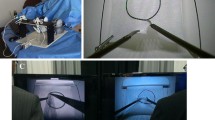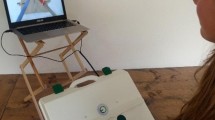Abstract
Background
The virtual basic laparoscopic skill trainer suturing simulator (VBLaST-SS©) was developed to simulate the intracorporeal suturing task in the FLS program. The purpose of this study was to evaluate the training effectiveness and participants’ learning curves on the VBLaST-SS© and to assess whether the skills were retained after 2 weeks without training.
Methods
Fourteen medical students participated in the study. Participants were randomly assigned to two training groups (7 per group): VBLaST-SS© or FLS, based on the modality of training. Participants practiced on their assigned system for one session (30 min or up to ten repetitions) a day, 5 days a week for three consecutive weeks. Their baseline, post-test, and retention (after 2 weeks) performance were also analyzed. Participants’ performance scores were calculated based on the original FLS scoring system. The cumulative summation (CUSUM) method was used to evaluate learning. Two-way mixed factorial ANOVA was used to compare the effects of group, time point (baseline, post-test, and retention), and their interaction on performance.
Results
Six out of seven participants in each group reached the predefined proficiency level after 7 days of training. Participants’ performance improved significantly (p < 0.001) after training within their assigned group. The CUSUM learning curve shows that one participant in each group achieved 5% failure rate by the end of the training period. Twelve out of fourteen participants’ CUSUM curves showed a negative trend toward achieving the 5% failure rate after further training.
Conclusion
The VBLaST-SS© is effective in training laparoscopic suturing skill. Participants’ performance of intracorporeal suturing was significantly improved after training on both systems and was retained after 2 weeks of no training.






Similar content being viewed by others
References
Rogers SO, Gawande AA, Kwaan M, Puopolo AL, Yoon C, Brennan TA, Studdert DM (2006) Analysis of surgical errors in closed malpractice claims at 4 liability insurers. Surgery 140:25–33. https://doi.org/10.1016/j.surg.2006.01.008
Stefanidis D, Montero P, Urbach DR, Qureshi A, Perry K, Bachman SL, Madan A, Petersen R, Pryor AD (2014) SAGES research agenda in gastrointestinal and endoscopic surgery: updated results of a Delphi study. Surg Endosc 28:2763–2771. https://doi.org/10.1007/s00464-014-3535-5
Vassiliou MC, Dunkin BJ, Marks JM, Fried GM (2010) FLS and FES: comprehensive models of training and assessment. Surg Clin North Am 90:535–558
Scott DJ, Dunnington GL (2008) The new ACS/APDS skills curriculum: moving the learning curve out of the operating room. J Gastrointest Surg 12:213–221. https://doi.org/10.1007/s11605-007-0357-y
Fried GM, Feldman LS, Vassiliou MC, Fraser SA, Stanbridge D, Ghitulescu G, Andrew CG (2004) Proving the value of simulation in laparoscopic surgery. Ann Surg 240:518–528. https://doi.org/10.1097/01.sla.0000136941.46529.56
Fried GM (2008) FLS assessment of competency using simulated laparoscopic tasks. J Gastrointest Surg 12:210–212. https://doi.org/10.1007/s11605-007-0355-0
Peters JH, Fried GM, Swanstrom LL, Soper NJ, Sillin LF, Schirmer B, Hoffman K, the SAGES FLS Committee (2004) Development and validation of a comprehensive program of education and assessment of the basic fundamentals of laparoscopic surgery. Surgery 135:21–27. https://doi.org/10.1016/S0039-6060(03)00156-9
Qi D, Panneerselvam K, Ahn W, Arikatla V, Enquobahrie A, De S (2017) Virtual interactive suturing for the fundamentals of laparoscopic surgery (FLS). J Biomed Inform 75:48–62. https://doi.org/10.1016/j.jbi.2017.09.010
Anton NE, Sawyer JM, Korndorffer JR, DuCoin CG, McRary G, Timsina LR, Stefanidis D (2018) Developing a robust suturing assessment: validity evidence for the intracorporeal suturing assessment tool. Surgery 163:560–564. https://doi.org/10.1016/j.surg.2017.10.029
Stefanidis D, Hope WW, Korndorffer JR, Markley S, Scott DJ (2010) Initial laparoscopic basic skills training shortens the learning curve of laparoscopic suturing and is cost-effective. J Am Coll Surg 210:436–440. https://doi.org/10.1016/j.jamcollsurg.2009.12.015
Mattar SG, Alseidi AA, Jones DB, Jeyarajah DR, Swanstrom LL, Aye RW, Wexner SD, Martinez JM, Ross SB, Awad MM, Franklin ME, Arregui ME, Schirmer BD, Minter RM (2013) General surgery residency inadequately prepares trainees for fellowship: results of a survey of fellowship program directors. Ann Surg 258:440–447. https://doi.org/10.1097/SLA.0b013e3182a191ca
Chellali A, Zhang L, Sankaranarayanan G, Arikatla VS, Ahn W, Derevianko A, Schwaitzberg SD, Jones DB, DeMoya M, Cao CGL (2014) Validation of the VBLaST peg transfer task: a first step toward an alternate training standard. Surg Endosc 28:2856–2862. https://doi.org/10.1007/s00464-014-3538-2
Awtrey C, Chellali A, Schwaitzberg S, De S, Jones D, Cao C (2015) Validation of the VBLaST: a virtual peg transfer task in gynecologic surgeons. J Minim Invasive Gynecol 22:1271–1277. https://doi.org/10.1016/j.jmig.2015.07.015
Sankaranarayanan G, Lin H, Arikatla VS, Mulcare M, Zhang L, Derevianko A, Lim R, Fobert D, Cao C, Schwaitzberg SD, Jones DB, De S (2010) Preliminary face and construct validation study of a virtual basic laparoscopic skill trainer. J Laparoendosc Adv Surg Tech 20:153–157. https://doi.org/10.1089/lap.2009.0030
American Educational Research Association, American Psychological Association, National Council on Measurement in Education, Joint Committee on Standards for Educational, Psychological Testing (US) (2014) Standards for educational and psychological testing. Amer Educational Research Assn
Fu Y, Cavuoto L, Qi D, Panneerselvam K, Yang G, Artikala VS, Enquobahrie A, De S, Schwaitzberg SD (2018) Validation of a virtual intracorporeal suturing simulator. Surg Endosc. https://doi.org/10.1007/s00464-018-6531-3
Cook JA, Ramsaya CR, Fayers P (2004) Statistical evaluation of learning curve effects in surgical trials. Clin Trials J Soc Clin Trials 1:421–427. https://doi.org/10.1191/1740774504cn042oa
Cook JA, Ramsay CR, Fayers P (2007) Using the literature to quantify the learning curve: a case study. Int J Technol Assess Health Care 23:255–260. https://doi.org/10.1017/S0266462307070341
Khan N, Abboudi H, Khan MS, Dasgupta P, Ahmed K (2014) Measuring the surgical “learning curve”: methods, variables and competency. BJU Int 113:504–508. https://doi.org/10.1111/bju.12197
Fraser SA, Klassen DR, Feldman LS, Ghitulescu GA, Stanbridge D, Fried GM (2003) Evaluating laparoscopic skills. Surg Endosc 17:964–967. https://doi.org/10.1007/s00464-002-8828-4
Feldman LS, Cao J, Andalib A, Fraser S, Fried GM (2009) A method to characterize the learning curve for performance of a fundamental laparoscopic simulator task: defining “learning plateau” and “learning rate”. Surgery 146:381–386. https://doi.org/10.1016/j.surg.2009.02.021
Diesen DL, Erhunmwunsee L, Bennett KM, Ben-David K, Yurcisin B, Ceppa EP, Omotosho PA, Perez A, Pryor A (2011) Effectiveness of laparoscopic computer simulator versus usage of box trainer for endoscopic surgery training of novices. J Surg Educ 68:282–289. https://doi.org/10.1016/j.jsurg.2011.02.007
Linsk AM, Monden KR, Sankaranarayanan G, Ahn W, Jones DB, De S, Schwaitzberg SD, Cao CGL (2018) Validation of the VBLaST pattern cutting task: a learning curve study. Surg Endosc Other Interv Tech 32:1990–2002. https://doi.org/10.1007/s00464-017-5895-0
Fraser SA, Feldman LS, Stanbridge D, Fried GM (2005) Characterizing the learning curve for a basic laparoscopic drill. Surg Endosc Other Interv Tech 19:1572–1578. https://doi.org/10.1007/s00464-005-0150-5
Zhang L, Sankaranarayanan G, Arikatla VS, Ahn W, Grosdemouge C, Rideout JM, Epstein SK, De S, Schwaitzberg SD, Jones DB, Cao CGL (2013) Characterizing the learning curve of the VBLaST-PT© (Virtual Basic Laparoscopic Skill Trainer). Surg Endosc 27:3603–3615. https://doi.org/10.1007/s00464-013-2932-5
Nemani A, Ahn W, Cooper C, Schwaitzberg S, De S (2018) Convergent validation and transfer of learning studies of a virtual reality-based pattern cutting simulator. Surg Endosc 32:1265–1272. https://doi.org/10.1007/s00464-017-5802-8
Stefanidis D, Korndorffer JR, Markley S, Sierra R, Heniford BT, Scott DJ (2007) Closing the gap in operative performance between novices and experts: does harder mean better for laparoscopic simulator training? J Am Coll Surg 205:307–313. https://doi.org/10.1016/j.jamcollsurg.2007.02.080
Korndorffer JR, Dunne JB, Sierra R, Stefanidis D, Touchard CL, Scott DJ (2005) Simulator training for laparoscopic suturing using performance goals translates to the operating room. J Am Coll Surg 201:23–29. https://doi.org/10.1016/j.jamcollsurg.2005.02.021
Derossis AM, Fried GM, Abrahamowicz M, Sigman HH, Barkun JS, Meakins JL (1998) Development of a model for training and evaluation of laparoscopic skills. Am J Surg 175:482–487. https://doi.org/10.1016/S0002-9610(98)00080-4
McCarter FD, Luchette FA, Molloy M, Hurst JM, Davis K, Johannigman JA, Frame SB, Fischer JE (2000) Institutional and individual learning curves for focused abdominal ultrasound for trauma: cumulative sum analysis. Ann Surg 231:689–700. https://doi.org/10.1097/00000658-200005000-00009
de Oliveira Filho GR (2002) The construction of learning curves for basic skills in anesthetic procedures: an application for the cumulative sum method. Anesth Analg 95:411–416. https://doi.org/10.1213/00000539-200208000-00033
Harrysson IJ, Cook J, Sirimanna P, Feldman LS, Darzi A, Aggarwal R (2014) Systematic review of learning curves for minimally invasive abdominal surgery. Ann Surg 260:37–45. https://doi.org/10.1097/SLA.0000000000000596
Vossen C, Van Ballaer P, Shaw RW, Koninckx PR (1997) Effect of training on endoscopic intracorporeal knot tying. Hum Reprod 12:2658–2663. https://doi.org/10.1093/humrep/12.12.2658
Stefanidis D, Korndorffer JR, Heniford BT, Scott DJ (2007) Limited feedback and video tutorials optimize learning and resource utilization during laparoscopic simulator training. Surgery 142:202–206. https://doi.org/10.1016/j.surg.2007.03.009
Stefanidis D, Korndorffer JR, Markley S, Sierra R, Scott DJ (2006) Proficiency maintenance: impact of ongoing simulator training on laparoscopic skill retention. J Am Coll Surg 202:599–603. https://doi.org/10.1016/j.jamcollsurg.2005.12.018
Jaffer U, Cameron AEP (2008) Laparoscopic appendectomy: a junior trainee’s learning curve. JSLS J Soc Laparoendosc Surg 12:288–291
Yap CH, Colson ME, Watters DA (2007) Cumulative sum techniques for surgeons: a brief review. ANZ J Surg 77:583–586. https://doi.org/10.1111/j.1445-2197.2007.04155.x
Waller HM, Connor SJ (2009) Cumulative sum (Cusum) analysis provides an objective measure of competency during training in endoscopic retrograde cholangio-pancreatography (ERCP). Hpb 11:565–569. https://doi.org/10.1111/j.1477-2574.2009.00091.x
Lee YK, Ha YC, Hwang DS, Koo KH (2013) Learning curve of basic hip arthroscopy technique: CUSUM analysis. Knee Surgery Sport Traumatol Arthrosc 21:1940–1944. https://doi.org/10.1007/s00167-012-2241-x
Bartlett A, Parry B (2001) Cusum analysis of trends in operative selection and conversion rates for laparoscopic cholecystectomy. ANZ J Surg 71:453–456. https://doi.org/10.1046/j.1440-1622.2001.02163.x
O’Connor A, Schwaitzberg SD, Cao CGL (2008) How much feedback is necessary for learning to suture? Surg Endosc Other Interv Tech 22:1614–1619. https://doi.org/10.1007/s00464-007-9645-6
Bonrath EM, Weber BK, Fritz M, Mees ST, Wolters HH, Senninger N, Rijcken E (2012) Laparoscopic simulation training: testing for skill acquisition and retention. Surg (United States) 152:12–20. https://doi.org/10.1016/j.surg.2011.12.036
Acknowledgements
Research reported in this publication was supported by the National Institute of Biomedical Imaging and Bioengineering of the National Institutes of Health under Award Number R44EB019802. The content is solely the responsibility of the authors and does not necessarily represent the official views of the National Institutes of Health.
Author information
Authors and Affiliations
Corresponding author
Ethics declarations
Disclosures
Dr. Schwaitzberg has no relevant conflicts related to this manuscript and is a consultant for Activ Surgical, Human Extensions, Arch Therapeutics, Acuity Bio, and Nu View Surgical.Yaoyu Fu , Lora Cavuoto, Di Qi, Karthikeyan Panneerselvam, Venkata Sreekanth Arikatla, Andinet Enquobahrie, and Suvranu De have no conflicts of interest or financial ties to disclose.
Additional information
Publisher's Note
Springer Nature remains neutral with regard to jurisdictional claims in published maps and institutional affiliations.
Rights and permissions
About this article
Cite this article
Fu, Y., Cavuoto, L., Qi, D. et al. Characterizing the learning curve of a virtual intracorporeal suturing simulator VBLaST-SS©. Surg Endosc 34, 3135–3144 (2020). https://doi.org/10.1007/s00464-019-07081-6
Received:
Accepted:
Published:
Issue Date:
DOI: https://doi.org/10.1007/s00464-019-07081-6




